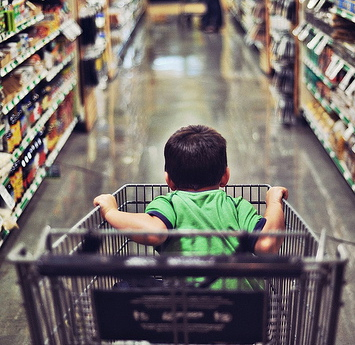It’s no surprise that gigantic, It�

Wenonah Hauter.
The corporate control and consolidation of the food industry is the central theme of Wenonah Hauter’s new book, Foodopoly: The Battle Over the Future of Food and Farming in America. Hauter, the executive director of Food & Water Watch, explores “the battle over the food and farming in America” as independent farmers and companies struggle to stay afloat in the face of corporate mergers and bad food policy.
But before you put down your (Kellogg-produced) Gardenburger to protest your local cattle ranch, Hauter warns a bigger response is required. “[I]t’s time that we stop demonizing farmers as the chief culprits behind our dysfunctional food system and start addressing the structural issues,” she says.
I recently chatted with Hauter over email about Foodopoly. She talks about how the system got the way it did, and what you can do to fix it:
Q. Give us a snapshot of the history of food-industry consolidation.
A. Just 20 companies produce most of the food eaten by Americans (yes, even organic brands). These companies are so large, they have the economic and political power to dictate food policy, from laws on advertising junk food to children and manipulating nutrition standards to weakening federal pesticide regulations and blocking the labeling of genetically engineered foods.
They have been able to become so large because of the evisceration of antitrust law during the Reagan administration. And since that time, no U.S. president has been willing to tackle the issue of concentration. This is ironic since all of the rhetoric about our economic system revolves around competition in the marketplace, but all public policy drives a frenzy of mergers and acquisitions. This is especially true in the food industry.
Q. What are the prospects for reversing course in the near future?
A. Consolidation is likely to continue and even accelerate over the next few years. Although the pace of mergers stalled during the economic recession, there are signs that merger and acquisition activity has started to pick back up. Just since Thanksgiving, two [food] mega-mergers have been announced. ConAgra is purchasing Ralcorp, the nation’s leading manufacturer of store-brand food, and JBS, the world’s largest meatpacker, is purchasing the second-largest Canadian meatpacker, XL Foods. XL Foods made headlines earlier this year after significant food safety lapses allowed 2.5 million pounds of potentially E. coli-tainted ground beef to enter the marketplace.
Q. What does the ConAgra-Ralcorp merger mean for the food system?
A. The companies only compete head-to-head for a few products (like peanut butter and some frozen dinners), but they compete alongside one another for supermarket shelf space. For example, ConAgra makes a wide range of popcorn snacks (Jiffy Pop, Orville Redenbacher, Fiddle Faddle, and Act II) and half of store-brand pretzels. Ralcorp makes corn and tortilla chips, snack mixes, nearly half of store-brand snack nuts, and two-thirds of store-brand crackers. For a consumer standing in the snack aisle, choosing between different snacks based on price, these are competitors. Unfortunately, federal regulators do not believe that mergers between conglomerates affect consumers unless they compete directly for the same narrowly defined products.
Q. I don’t think most people get that very little of the money we spend on mass-produced foods goes to farmers. How much does a corn farmer get, for instance, when we buy soda made with corn syrup?
A. Tufts University researchers estimate that soft drink companies have saved almost a billion dollars during a nine-year period after deregulation when corn prices were lowered, and that large meat companies saved nearly $4 billion on animal feed between 1997 and 2005. Contrast this to what farmers receive for growing corn. They get 4 to 5 cents from the sale of a box of corn flakes and 2 to 3 cents from the sale of a full-sized bag of corn chips. The corn content of a soda in the form of high-fructose corn syrup nets the farmer 2 cents out of each consumer dollar. Ninety-eight cents goes to the food companies that make, market, and sell soda.
Q. As you mentioned earlier, since the 1980s, a plethora of deregulation has occurred. Is reversing some of that deregulation a plausible goal, or at this point is it more feasible to simply prevent further deregulation?
A. Ultimately, to create a fair and healthy food system we need to build the political power to create commonsense regulations — and enforce them — for food safety and labeling, antitrust policy, biotechnology, and other new technologies used in the food system. This means having our eye on the long-term prize of a regulatory system that really works. Laying out what this ideal regulatory system should look like also creates more political space for achieving short-term goals and mobilizing more people. Activists are really tired of fighting for just the best they can get in the latest fight over some terrible deregulation scheme. We must fight for what we really want.
We are always faced with attempts to weaken the rules that are already on the books, even if they are already inadequate. Food safety is a good example. We have spent the last year battling a proposal from the USDA to privatize the inspection of poultry products and allow much faster line speeds in poultry plants, a move that would put consumer and worker safety at risk. Stopping these current deregulation attempts is not only necessary, but it also helps us to build the political power we will need to eventually fight for better food policies in the future.
Q. What’s your advice to someone beginning to read about these issues who feels overwhelmed by the system?
A. A natural response is to try and “shop better.” That’s important, and as you learn more you may end up questioning some products you’ve been buying for years. But as I say throughout my book, we can’t shop our way out of the problems in the food system.
Find a way to get involved in building a food movement that has the political power to change the rules for our food system. Find a local organization working on food policy in your community or do research on your local officials and how to contact them — then call them up and tell them you expect them to step up on a food issue that matters to you, whether it’s labeling [genetically engineered] foods or passing a better farm bill.




